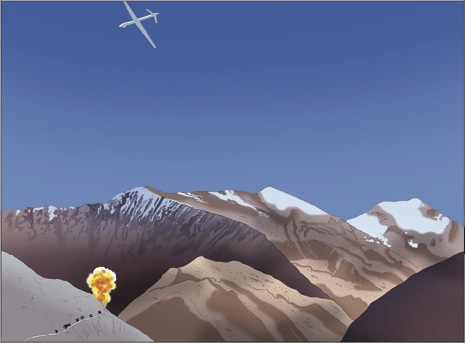
Remembering Daraz Khan, the first Afghan killed by a Hellfire missile fired by a CIA Predator drone
"Tell the Americans it was a bad thing they did, a very bad thing."
Reading time: (Number of words: )
On February 4, 2002, three men set out from the village of Lalazha in Paktia Province. They were Mir Ahmed, age 30, Jehangir Khan, age 28, and his cousin Daraz Khan, age 31. Daraz Khan was known as “tall man Khan” because of his five-foot, eleven-inch (180 centimeters) height. Daraz was from Lalazha and his two friends were from the nearby village of Patalan.
The three walked 16 kilometers in the snow to the Zhawar Caves, which are located in the hills south of Khost. A month earlier, the United States military spent two weeks bombing 35 cave openings in this area, which is an old military base of Jalaluddin Haqqani. U.S. Intelligence believed at the time that Usama bin Laden had moved to Zhawar from Tora Bora. Local militiamen laughed at the suggestion and we now know that in the winter of 2001, Usama bin Laden had moved from Tora Bora directly into Pakistan.
In the weeks after the bombing it was common for local villagers to trek into the Zhawar Caves area to collect scrap metal remains of the bombs and their targets, which included a collection of old rusting Soviet military vehicles. Local villagers get paid pennies per kilogram for scrap metal either in Khost or across the border in Pakistan.
At approximately 3 p.m., the three villagers had climbed up on a bluff above the caves. They were at a height of about 3,300 meters. They were standing together in the open, chatting, when they were struck by at least one AGM - 114 Hellfire missile that had been fired by a CIA MQ-1 Predator drone. Two were killed instantly and the third died a short while later.
At a Pentagon briefing, a military spokesman argued that the CIA thought that Mr. Khan might be Usama Bin Laden, even though the latter is much taller than Daraz Khan. The spokesman defended the air strike by stating that Daraz Khan was acting “al-Qaeda like,” a term he refused to explain. Over the next few days a procession of Pentagon officials added their opinions:
- Pentagon spokeswoman Victoria Clark said: “We’re convinced that it was an appropriate target, although we do not know exactly who it was.”
- General Tommy Franks told ABC News on February 7, 2002, that he expected the identities of the three to prove “interesting.”
- Rear Admiral John Stufflebeem said that the three were “meeting on a hillside” and then added that they were “not farming up there.”
- A Pentagon source then told the American news media that the Pentagon is pretty confident the three were “senior al-Qaeda members.”
The Pentagon announced that a 50-member investigating team was on-site collecting DNA samples and other evidence. The results of that investigation were never disclosed to the public. The Pentagon suddenly imposed a news blackout on all information regarding the killings. Daraz Khan’s brother Shawol Khan was interviewed and he confirmed that the three were out collecting scrap metal.
The Pentagon and CIA have never admitted that they killed three innocent civilians. The families of the three men have apparently never received any compensation. The three were buried together under the simple inscription which read: “In the name of Allah.”
While accidents happen, it is important to discover what went wrong on February 2, 2002. These three men deserve justice. They certainly would want to know that procedures have improved such that this mistake cannot happen again, especially now that President Barak Obama has authorized an increase in Predator strikes in the Afghanistan/Pakistan border regions. Sweeping this incident under the rug is not honorable.
History tells us that countries engaged in counter-terrorism have to be careful when they undertake these types of killings. There was universal outrage at the Mossad’s mistaken execution of Ahmed Bouchiki in Lillehammer, Norway on July 21, 1973. Likewise, during Operation Restore Hope, a Cobra helicopter fired ten TOW missiles on July 12, 1993, at the family home of Mohamed Farah Aydid in Mogadishu. He was not at home, but the missiles killed 50 people, including clan elders. It was a disastrous mistake.
The U.S. Embassy in Kabul should issue a detailed press release which explains what happened on February 2, 2002, and the steps taken to ensure that such an incident will not reoccur. The Embassy should also confirm that reparations have finally been made to the three families.
The New York Times ran a story on February 17, 2002, concerning this incident. Reporter John F. Burns went to Lalazha village and met with family members. He interviewed Irana, the 8-year old niece of Daraz Khan. She summed up the sad case of Daraz Khan. She told the reporter: “Tell them (the Americans) it was a bad thing they did, a very bad thing.”

Poems for the Hazara
The Anthology of 125 Internationally Recognized Poets From 68 Countries Dedicated to the Hazara
Order Now










Forum posts
5 January 2010, 23:57, by hazarbuz
remembering the guy who blow him self in CIA hub base in khost and kill at least 9 people , from this 9 people 7 was CIA counter terrorist officer and one was Jordanian military kernel and one was the base chief . name of this guy was ( khalil abu malal albalawie ) . CIA promises to take revenge from afghan and Jordanian too .